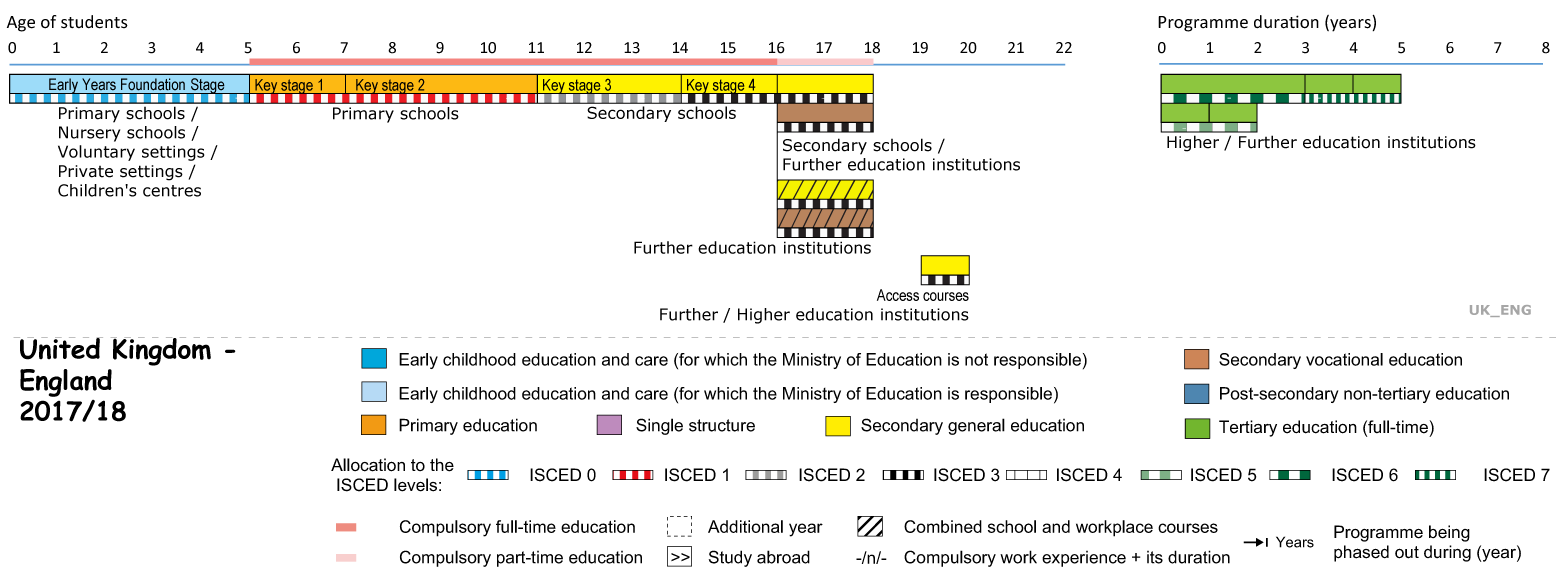 Key features of the education system
Key features of the education system
Overall responsibility
Overall responsibility for the education system in England lies with the UK Government’s Department for Education (DfE). Unlike Scotland, Wales and Northern Ireland, England does not have its own devolved government.
Responsibility for participation
Parents are responsible for ensuring a child of compulsory school age (5 to 16) receives efficient full-time education suitable to their age, ability, aptitude, and to any special educational needs they may have, by regular attendance at school or otherwise. Although education is compulsory, school is not, and parents may educate their child at home without seeking approval.
There is also a requirement on the young person (16+) to participate in one of the following until 18:
- full-time education
- an apprenticeship or traineeship
- 20 hours minimum per week of work or volunteering while in part-time education or training.
Local authorities (LAs) must help children who are missing education get back into education. They must also promote the participation in education and training of 16- and 17-year-olds and identify those who are not in education, employment or training (NEET).
Governance and accountability
Reforms in the 1980s and 1990s changed the balance of responsibilities for publicly funded education outside of higher education. Schools became more autonomous as responsibility for staffing and budgets was delegated to each school’s governing body. Further education colleges were incorporated as autonomous bodies. A national accountability framework was developed, with outcomes for learners based on attainment in externally provided tests and qualifications. In 1992, external inspection by Ofsted was established. A common inspection framework is used to inspect early childhood education and care providers, schools, colleges, work-based learning and adult education providers. Inspection reports are published. Providers may be subject to intervention if important areas for improvement exist.
Further reforms have affected schools since 2010. Academies now form a substantial minority of primary and a majority of secondary schools and, in many academies, accountability has shifted from the local governing body to a central trustee board in a multi-academy trust (MAT). Eight regional schools commissioners provide oversight of academies and now also of underperforming maintained schools.
Although their role has greatly reduced since the 1980s, local authorities retain a duty to ensure a sufficient supply of school places; support school improvement; and support vulnerable children and young people.
There is a strong tradition of private education in England. Independent schools, other than academies, receive no direct public funding.
School curriculum
The school curriculum is framed by broad aims to promote the spiritual, moral, cultural, mental and physical development of pupils and to prepare them for the opportunities, responsibilities and experiences of later life, first established by the Education Act 1944. A national curriculum was introduced under the Education Reform Act 1988, giving pupils an entitlement to a broad and balanced curriculum and setting standards for attainment. Re-enacted by the Education Act 2002, and last revised in 2014, the national curriculum specifies compulsory subjects, programmes of study and entitlement areas for ages 5-16, although it does not prescribe teaching hours. It sits alongside requirements for religious education, sex education and careers education, and is compulsory for maintained schools but not academies.
Pupils are organised into year groups according to their age and may be taught for some subjects according to ability. Grade repetition and early tracking into different study programmes are not typical.
Qualifications
From age 14, the curriculum is framed by external qualifications, provided by independent awarding organisations and regulated by Ofqual. Qualifications are assigned levels of difficulty on the Regulated Qualifications Framework (RQF), which accommodates all regulated general and vocational qualifications outside of higher education.
Qualifications can be taken at any age, providing a structure for progression from school to adult learning.
General and vocational qualifications have undergone considerable reform since 2010, with the aim of improving relevance and rigour.
Higher education autonomy
Higher education institutions (HEIs) are private bodies that, subject to their degree-awarding powers, are free to design programmes and awards and to determine the conditions on which they are awarded. There is no system for the accreditation of HEIs, but their capability to manage their own quality and standards is assessed by the Quality Assurance Agency for Higher Education (QAA), with the UK Quality Code as the reference point. A new regulatory framework in 2017 was established, overseen by the Office for Students (OfS). This seeks to facilitate new high-quality providers to start up, achieve degree-awarding powers and secure university title. The OfS operates the Teaching Excellence Framework (TEF) to recognise and reward high-quality teaching in HE.
There has been a shift from direct public funding for teaching to tuition fees backed by public loans, with new fee regimes introduced in 2006 and 2012.
Research infrastructure is supported by block grant funding, allocated on the basis of the Research Excellence Framework (REF), while grants are awarded for specific projects and programmes.
Stages of the education system
Full-time education is compulsory from the term following a child’s 5th birthday until they turn 16. Young people must be in full- or part-time education or training until they are 18.
ISCED 0
Part-time provision is free of charge to parents for all children from age 3 and disadvantaged children from 2. For children of working parents, the entitlement is 30 (instead of 15) hours a week.
From age 4 to 5, most children attend a primary school reception class full time.
A common statutory framework regulates childcare provision from 0 to 5 across settings, including nursery schools, maintained primary schools and academies, private and voluntary settings and registered childminders.
ISCED 1
Primary education consists of Key Stage 1 for ages 5 to 7 and Key Stage 2 for ages 7 to 11.
Primary schools are either maintained schools or academies. Almost all are mixed-sex and around a third are faith schools.
National tests in English and maths at 11 are important for school accountability but do not influence admission to secondary school.
ISCED 2
Key Stage 3 is for ages 11 to 14. It is provided in secondary schools catering for pupils from 11 to 16 or 18/19.
Secondary schools are either maintained schools or academies. They can be mixed- or single-sex and around a fifth are faith schools. Most admit pupils without reference to academic criteria. In a few areas, grammar schools select pupils on the basis of performance in an exam.
ISCED 3
Key Stage 4
Pupils normally continue at the same secondary school for Key Stage 4, which is for ages 14 to 16.
Attainment at the end of Key Stage 4 is measured mainly through GCSEs. Vocational qualifications, including technical awards, may be offered alongside these.
These qualifications are important for school accountability and for individuals’ progression in education/training and transition to the labour market.
16 to 18/19
From age 16 to 18/19, young people must be in full- or part-time education or training. They may continue at the same secondary school in the sixth form; in another school sixth form; in a sixth-form college; in a further education (FE) college; or start an apprenticeship or traineeship.
Study programmes can contain a mix of general and vocational qualifications. Most general routes lead to two or three A Levels (Level 3 qualifications). FE colleges typically offer a wider range of vocational options at Level 3, including Applied General Qualifications in a vocational area, and Tech levels in a recognised occupation. Pupils not yet ready for Level 3 study can complete technical certificates (Level 2 qualifications relating to a specific industry, occupation or occupational group). Level 1 and Entry Level qualifications are also available.
Apprenticeships are work-based training programmes for individuals not in full-time education aged 16 and over. They can be completed at different qualification levels.
Traineeships are for young people not ready to start an apprenticeship.
Adult learning
Adult learning includes apprenticeships and provision to raise achievement in basic skills, focusing mainly on English and maths qualifications. Most publicly funded programmes lead to a regulated qualification on the RQF. Other programmes encourage the hardest-to-reach adults back to learning and employment.
ISCED 5,6,7,8
Programmes are structured on a five-level framework which aligns with the five highest RQF levels and with three cycles of bachelor’s, master’s and doctoral studies. The framework includes short programmes such as foundation degrees and postgraduate certificates.
Programmes are offered by HEIs, FE colleges, and alternative providers. Institutions determine their admissions policies and wide variations in competition for places exist. A Levels are the most common entry qualification to bachelor programmes, but other qualifications may be accepted. Well-established routes, such as Access programmes, exist for mature learners who lack formal qualifications.
Structure of the national education system
Resource: https://eacea.ec.europa.eu/national-policies/eurydice/content/united-kingdom-england_en









